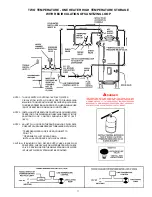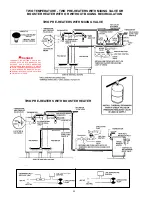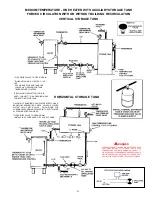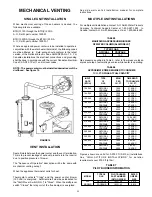
10
CONFINED SPACE
When drawing combustion and dilution air from inside a
conventionally constructed building to a confined space, such a
space shall be provided with two permanent openings, ONE IN
OR WITHIN 12 INCHES (30.5cm) OF THE ENCLOSURE TOP
AND ONE IN OR WITHIN 12 INCHES (30.5cm) OF THE
ENCLOSURE BOTTOM. Each opening shall have a free area of
at least one square inch per 1000 Btuh (2,225mm
2
/Kw) of the
total input of all appliances in the enclosure, but not less than
100 square inches (645 square cm).
If the confined space is within a building of tight construction, air
for combustion, ventilation, and draft hood dilution must be
obtained from outdoors. When directly communicating with the
outdoors or communicating with the outdoors through vertical
ducts, two permanent openings, located in the above manner,
shall be provided. Each opening shall have a free area of not
less than one square inch per 4000 Btuh (8,900mm
2
/Kw) of the
total input of all appliances in the enclosure. If horizontal ducts
are used, each opening shall have a free area of not less than
one square inch per 2000 Btuh (4,450mm
2
/Kw) of the total input
of all appliances in the enclosure. For Canadian installations
consult CAN/CSA B149.1-00.
VENT REDUCER
The BTR(C) 250, 251, and 275 models are shipped with an 8" to
6" diameter flue outlet adapter. The BTR(C) 120 models come
with an 6" to 5" diameter flue outlet adapter. Each adapter fits on
top of the installed flue damper. Use only vent reducers supplied
with the unit. The venting must comply with the NATIONAL FUEL
GAS CODE, ANSI Z223.1/NFPA 54 and for Canadian installations
consult the Canadian Installation Code CAN/CSA B149.1-00.
FIGURE 8
VENTING
WARNING
THE INSTRUCTIONS IN THIS SECTION ON VENTING MUST
BE FOLLOWED TO AVOID CHOKED COMBUSTION OR
RECIRCULATION OF FLUE GASES. SUCH CONDITIONS
CAUSE SOOTING OR RISKS OF FIRE AND ASPHYXIATION.
Heater must be protected from freezing downdrafts.
Remove all soot or other obstructions from the chimney that will
retard a free draft.
Type B venting is recommended with these heaters. See table 3
TECHNICAL DATA VENTING.
This water heater must be vented in compliance with all local
codes, the current revision of the National Fuel Gas Code (ANSI-
Z223.1) and with the Category I Venting Tables.
In Canada, venting shall conform to the requirements of the
current CAN/CGA B149.1-00 installation code.
If any parts of the vent system are exposed to ambient
temperatures below 35 degrees F (2 degrees C) they must be
insulated to prevent condensation.
• Do not connect the heater to a common vent or chimney with
solid fuel burning equipment. This practice is prohibited by
many local building codes as is the practice of venting gas
fired equipment to the duct work of ventilation systems.
• Where a separate vent connection is not available and the
vent pipe from the heater must be connected to a common
vent with an oil burning furnace, the vent pipe should enter
the smaller common vent or chimney at a point above the
large vent pipe.
CORRECT METHOD
OF VENT PIPE
INSTALLATION
INCORRECT INSTALLATION
WITH NO UPWARD
ANGLE
PROVIDE MAXIMUM VERTICAL RISE OF VENT PIPE DIRECTLY ABOVE
HEATER DRAFT HOOD BEFORE TURNING INTO HORIZONTAL RUN.
FIGURE 9
MULTIPLE HEATER MANIFOLD
Figure 10 and table 3 should be used for horizontally manifolding
two or more heaters. Also see MULTIPLE-UNIT INSTALLATIONS
of MECHANICAL VENTING section for induced draft applications.
FIGURE 10
WATER LINE CONNECTIONS
This manual provides detailed installation diagrams (see pages
16-22 of this manual) for typical methods of application for the
water heaters.
The water heater may be installed by itself, or with a separate
storage tank, on both single and two-temperature systems.
When used with a separate storage tank, the circulation may be
either by gravity or by means of a circulating pump. When a
circulating pump is used it is important to note that the flow rate
should be slow so that there will be a minimum of turbulence
inside the heater.











































